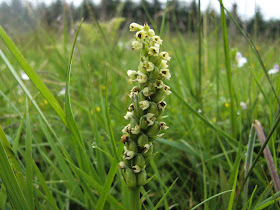 This weekend I've been to 2 sites that were spectacular for their flora and their orchid populations in particular. Gowk Bank NNR must be one of the most remote nature reserves in England. You have to be quite determined to get there. I took a wrong turn at one stage and ended up at an RAF base that isn't marked on the map. Very confusing (and a bit intimidating)! It has a mosaic of vegetation communities including some excellent herb-rich upland hay meadow communities. A lot of the vegetation there is much more acidic in character than most upland hay meadows I come across but still very very herb rich. I went there to have a look for Euphrasia rostkoviana for the warden. It was there in abundance which was nice to see. I got directions to find Pseudorchis albida and frog orchid. I found one spike of the Pseudorchis (see picture) but I couldn't find any frog orchids.
This weekend I've been to 2 sites that were spectacular for their flora and their orchid populations in particular. Gowk Bank NNR must be one of the most remote nature reserves in England. You have to be quite determined to get there. I took a wrong turn at one stage and ended up at an RAF base that isn't marked on the map. Very confusing (and a bit intimidating)! It has a mosaic of vegetation communities including some excellent herb-rich upland hay meadow communities. A lot of the vegetation there is much more acidic in character than most upland hay meadows I come across but still very very herb rich. I went there to have a look for Euphrasia rostkoviana for the warden. It was there in abundance which was nice to see. I got directions to find Pseudorchis albida and frog orchid. I found one spike of the Pseudorchis (see picture) but I couldn't find any frog orchids..jpg)
There were extensive areas of grassland that looked intermediate between U4c and M26 with some of the usual upland hay meadow plants but abundant Crepis paludosa and acidic species like Potentilla erecta, Galium saxatile, Juncus squarrosa and Nardus stricta. The whole site had loads of twayblade, Gymnadenia conopsea subsp. borealis (see picture) and the 3 common upland haymeadow Dactylorhiza species - fuchsii, maculata and purpurella - probably their hybrids as well (groan!).

Today Clare and I went to see a very species-rich pasture close to Allendale. The dry bits looked like U4c again which is similar to MG5c but a bit more acidic. I'm not used to seeing such species-rich acid grassland. There must be something strange about the soil and/or management of these communities that makes them so uncommon. In the original NVC books they were only recorded in Derbyshire but they are a lot more widespread than that although probably very uncommon everywhere they occur.
 This site was also very spectacular for its orchids. Surprisingly the only Dacylorhiza was fuchsii. Otherwise it had loads of twayblade, Gymnadenia conopsea subsp.borealis and greater butterfly orchid. This is a very rare plant in Northumberland - there are only a handful of sites for it in the county, mostly with a small number of plants in each one. One this site there were easily more than 1,000 plants in the field.
This site was also very spectacular for its orchids. Surprisingly the only Dacylorhiza was fuchsii. Otherwise it had loads of twayblade, Gymnadenia conopsea subsp.borealis and greater butterfly orchid. This is a very rare plant in Northumberland - there are only a handful of sites for it in the county, mostly with a small number of plants in each one. One this site there were easily more than 1,000 plants in the field.
Anyway, enough about orchids, you may never hear me talk about them again!
John
No comments:
Post a Comment